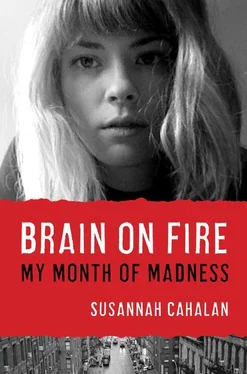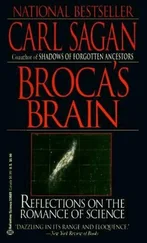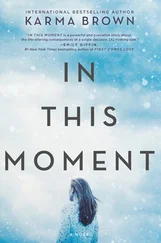Bipolar disorder. Even though it would have sounded grim at any other moment, now the idea was a relief. This made sense. A quick Google search revealed that the National Institute of Mental Health had a whole booklet dedicated to it: “a brain disorder that causes unusual shifts in moods” (yes); “often develops in a person’s late teens or early adult years” (yes); “an overly joyful state is called a manic episode, an extremely sad or hopeless state is called a depressive episode” (yes and yes, which equals a mixed state). 10Another site listed at length the famous people who were suspected to suffer from bipolar disorder: Jim Carrey, Winston Churchill, Mark Twain, Vivien Leigh, Ludwig van Beethoven, Tim Burton. 11The list kept going and going. I was in good company. “No great mind has ever existed without a touch of madness,” Aristotle said.
I spent the night in a state of ecstasy: I had a name for what plagued me, and those two words, which fell off the tongue so sweetly, meant everything. I didn’t even want to be “cured.” I now belonged to an exclusive club of creatives.
Unconvinced by my self-diagnosis, my mom and Allen drove me back to Dr. Bailey’s office that Monday, March 16. The Miró painting no longer seemed as menacing. It matched my mood disorder. Dr. Bailey called us in almost immediately. His demeanor this time seemed far less jolly and grandfatherly, though overall he was pleasant. Again, he went through the basic neurological exam and wrote down “normal.” Right then, I did feel normal. He jotted down notes on his pad as he asked me questions. Only later would I learn that he was missing details, writing down that I was “on a plane” when the first seizure occurred.
His tone was light when discussing the seizure, but then he slid his glasses down his nose, and suddenly sounded very serious. “Is your job very stressful?”
“Yes, I guess.”
“Do you feel overwhelmed at times?”
“Sure.”
“Tell me honestly,” he said, as if preparing himself for me to let him in on a big secret. “There are no judgments here. How much alcohol are you drinking a day?”
I had to think about it. I hadn’t had a drop of booze in the past week, but normally it helped me unwind, so I tended to have a sip of something most nights. “To be honest, about two glasses of wine a night. I usually split a bottle with my boyfriend, though he tends to drink more than I do.” He made a note of this in his chart. I didn’t understand that doctors usually doubled—even tripled—such numbers because patients often lie about their vices. Instead of two drinks a night, he probably believed the number was closer to six.
“Any drug use?”
“No. Not in years,” I said, and quickly added, “I did some research on bipolar disorder, and I really think that’s what I have.”
He smiled. “I don’t have any experience in this field, but it’s a possibility. The receptionist will refer you to a very capable psychiatrist who will have more experience with these types of issues.”
“Great.”
“Okay, then. Well, otherwise, everything looks normal to me. I’m going to draw you up a prescription for Keppra, an antiseizure medication. Take that, and everything should be fine. I’ll see you in two weeks,” he said and walked me to the waiting area. “I’m going to also have a little talk with your mother if you don’t mind.” He waved her into his office. After he had closed the door behind him, he turned to her.
“I think this is very simple. Plain and simple. She’s partying too hard, not sleeping enough, and working too hard. Make sure she doesn’t drink and takes the Keppra I prescribed, and everything should be fine.”
My mom was filled with immense relief. It was just the answer she wanted to hear.
CHAPTER 10
MIXED EPISODES

Allen drove us up to a prewar brownstone on the Upper East Side, where the psychiatrist, Sarah Levin, lived and worked. My mom and I walked to the entrance and pressed the buzzer. A Carol Kane falsetto trilled through the intercom: “Come right in and sit in the waiting area. I’ll be right with you.”
With its white walls, magazines, and bookcases filled with all the classics of literature, Dr. Levin’s waiting area seemed straight out of a Woody Allen film. I was excited to see the psychiatrist. I wanted her to confirm, once and for all, my bipolar self-diagnosis, but also I considered psychiatric visits entertaining on a certain level. For a period of time after an old breakup, I had gone to three separate psychologists, testing them out. The exercise was largely self-indulgent, inspired by watching too many episodes of the HBO show In Treatment . First I saw the attractive young gay man who acted like my best friend and enabler; then a green and geeky (but cheap) shrink who took my insurance and immediately asked me about my relationship with my father; then an old curmudgeon who tried to hypnotize me with a plastic wand.
“Come on in,” said Dr. Levin, appearing at the door. I smiled: she looked like Carol Kane too. She motioned for me to sit in the leather chair.
“I hope you don’t mind, but I always take pictures of my patients to keep track of everyone,” she said, nodding at the Polaroid camera in her hands. I posed, not sure if I should smile or remain serious. I remembered what my friend Zach from work had once told me years before when I first went on live television during the Michael Devlin affair: “Smile with your eyes.” So that’s what I tried to do.
“So tell me a bit about why you’re here,” she asked, cleaning her glasses.
“I’m bipolar.”
“I’m sorry,” she said. “Say that again?”
“I’m bipolar.”
She nodded as if agreeing with me. “Are you on any medication for that?”
“No. I haven’t been officially diagnosed. But I know. I mean, I know myself better than anyone, right? So I should know if I have it. And I know that I do,” I rambled on, the illness imposing itself on my speech patterns.
She nodded again.
“Tell me why you think you’re bipolar.”
As I made my case through my strange, jumpy logic, she jotted down her impressions on two pages of wide-ruled paper: “Said she had bipolar disorder. Hard to conclude,” she wrote. “Everything is very vivid. Started in last few days. Can’t concentrate. Easily distracted. Total insomnia but not tired, not eating. Has grand ideas. No hallucinations. No paranoid delusions. Always impulsive.”
Dr. Levin asked if I had any history of feeling this way and wrote, “She’s had hypomanic attacks her whole life. Always has high energy. But has negative thoughts. She was never suicidal.”
Dr. Levin’s opinion was that I was experiencing a “mixed episode,” meaning both manic and depressive elements typical of bipolar disorder. She moved several large books on her desk around until she found her scrip pad and scrawled out a prescription for Zyprexa, an antipsychotic prescribed to treat mood and thought disorders.
While I was in the office with Dr. Levin, my mother called my younger brother, a freshman at the University of Pittsburgh. Even though James was only nineteen, he already had a wise, old-soul quality that I’ve always found comforting.
“Susannah had a seizure,” she told James, trying to control the wavering of her voice. James was stunned. “The neurologist is saying she drank too much. Do you think Susannah is an alcoholic?” my mom asked him.
James was adamant. “No way is Susannah an alcoholic.”
“Well, Susannah’s insisting that she’s manic-depressive. Do you think that’s a possibility?”
Читать дальше













